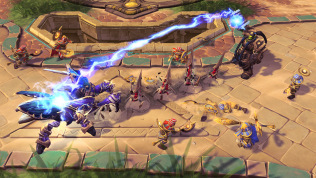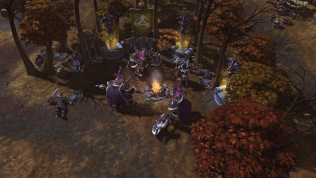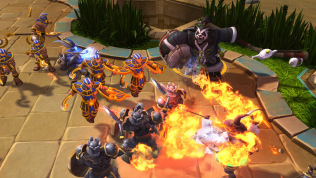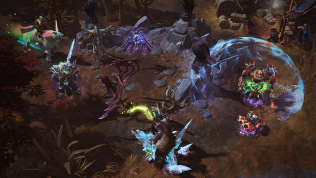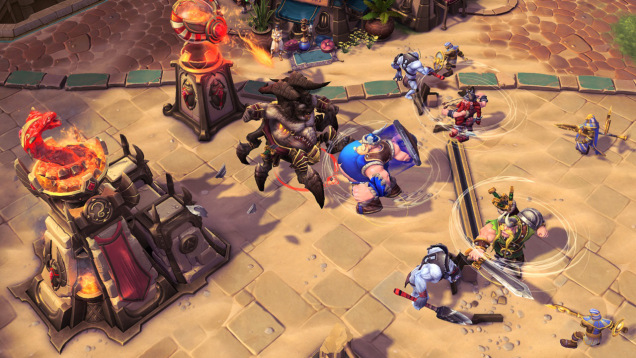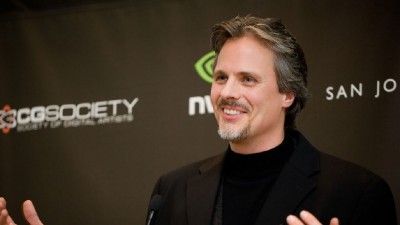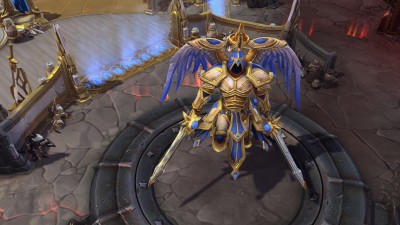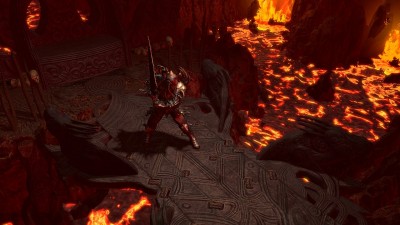Almost a year ago to the day I first previewed the Heroes of the Storm Technical Alpha and found it to be a well polished game that may or may not scratch your MOBA itch. Now in its full release and a year later, how will I find Blizzard’s entrance into the popular genre of games that was birthed out of the map editors from Warcraft 3?
Blizzard is keeping much in line with their recent game design philosophy of taking established genres with a steep learning curve, and making the more accessible to a wider audience. MOBAs in particular, with their online competitive nature, has sparked heated debates between the fans of the different games over which is best and holds the better player base. And while I will not step into the “casual vs hardcore” game hyperbole, I will be comparing several of the games to Heroes as I believe it is critical to understanding what this game is, and who it is for.
Blizzard has insisted on calling Heroes a hero brawler, but it’s a MOBA (Multiplayer Online Battle Arena) through and through. Teams of five players defend their base from the enemy team as waves of NPC creeps push up three different lanes in a strategic creep equilibrium. I’m not going to get into the finer details of what defines a MOBA (you can read this for a more detailed rundown), just know at the games core you are are selecting unique heroes from a vast pool to battle against other players or computers.
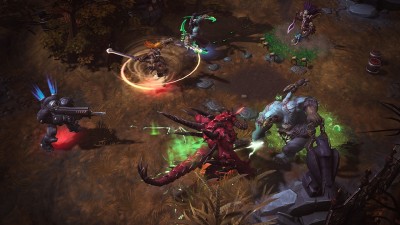 Nostalgia reigns high as the characters of Heroes are the stars of the show. One of Blizzards advantages over other newcomer MOBAs is their recognizable pool of popular and beloved characters that every fan of the company would love to play as. I mean, who doesn’t want to battle as Illidan Stormrage? Or call down thunder as Jim Raynor? Or even the Three Lost Vikings of yesteryear?
Nostalgia reigns high as the characters of Heroes are the stars of the show. One of Blizzards advantages over other newcomer MOBAs is their recognizable pool of popular and beloved characters that every fan of the company would love to play as. I mean, who doesn’t want to battle as Illidan Stormrage? Or call down thunder as Jim Raynor? Or even the Three Lost Vikings of yesteryear?
Currently the roster sits at a respectable 37 playable characters, and you can expect Blizzard to fill out the ranks to over 100 over the course of the coming years. They’ve pulled characters from some of their biggest franchises in Diablo, StarCraft, and Warcraft, but there are others from Blizzard’s entire backlog thrown in for some extra fan service.
Not only are the characters back, but many of the excellent voice cast have returned to breathe life into the heroes and villains that they helped to make beloved by fans. Some actors are returning to characters that they’ve not portrayed in almost ten years. My dream would be for Michael Gough to return as a playable Deckard Cain.
As is the case with other games in the genre, each character in Heroes has their individual strengths, weaknesses, and roles to play on any given team. Only here in Heroes are the characters more rigidly stuck in their defined roles, a system more aligned with League’s hero style. Which isn’t a bad thing, in fact it helps better serve new players when selecting a character as they’ll know who is a Warrior, Assassin, Support, or Specialist character.
Warriors are sturdy tank heroes that focus on soaking up a lot of damage on the front lines, but they can dish out as much as they receive while holding back opponents with disables; Assassins are fragile heroes, but can dish out immense amounts of damage in short bursts of aggression, before quickly retreating to safety; the Support class offers a wide range of abilities and talents that aid those around them, often healing those in need to prolong their fighting capabilities;. and finally, Specialist heroes are able to alter the flow of a match with their abilities, and can often deal heavy damage to buildings and objectives essential to victory.
I prefer to play the Support class. There’s no greater feeling than using Rehgar’s Ancestral Healing to save your tank from the brink of death, then watch them go on to decimate the 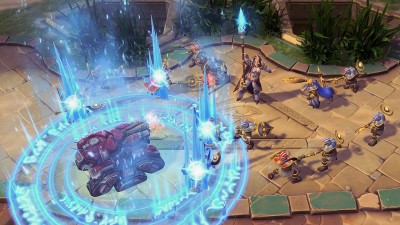 weakened team. But the choice is yours, and many of the classes themselves have flexibility within their roles. Warriors can focus on more survivability or damage, Assassins can pick up even more damage or mobility, and so on. Just like in other MOBAs you need to learn your role to better help your team to victory.
weakened team. But the choice is yours, and many of the classes themselves have flexibility within their roles. Warriors can focus on more survivability or damage, Assassins can pick up even more damage or mobility, and so on. Just like in other MOBAs you need to learn your role to better help your team to victory.
Blizzard has eased the learning process of their game and the genre by making several important changes to the formula. Most notably, the need to purchase item has been removed, instead the focus is placed on talents acquired from leveling up. Blizzard frequently states that they want to make all of the talents viable choices for players to further add to the games complexity. The removal of items has also lead to the lack of a need for gold as a manageable resource, everything is gained through levels.
Another major change is how your characters level up, instead of needing to focus on last hits your entire team will share experience across the board. Meaning that if one person gets a kill on the top lane, your whole team will reap the gains of said kill. This helps to alleviate the problems of lesser skilled players dragging the entire team down because of their inability to farm gold or experience. This furthers the competitive feel of individual maps and also relieves player griefing and aggression towards teammates.
However, I feel this has created some unintended results; most games at the skill level I was playing at quickly turned into five-man team pushes in opposing lanes once the map objectives had been triggered. Now, this could be because so many newer players aren’t familiar with the meta or the map objective-focused gameplay, but currently there seems to be less strategy involved in a base race. Plus, any players who like to solo in other games will almost certainly get caught and killed by a roaming band of enemy players here.
Watching pro-matches of Heroes showed me that your team needs to constantly be grouping and ganking objectives and heroes to win matches, and many players aren’t on board with that as of yet. Blizzard has always fostered competitiveness in their games, but it’s generally been one-on-one. Here, the focus really is on organized teamwork, and with such a lengthy spell in closed and open beta, many players are already at a highly advanced level.
Shorter games also lead to swift victories for the first team to establish any sort of lead or advantage over the other. There’s less time to recover your position should you stumble early, and a good team will capitalize on your mistakes by capturing map objectives and mercenary camps to increase their lead further. The back and forth swing of games is essential to what makes pro-matches of MOBAs so compelling to watch. If you’ve turned on Twitch at all in the last week, you’ll see how much money Blizzard is putting into making Heroes a serious part of the eSports conversation.
All of this plays into Blizzard’s current game design philosophy of taking established, but often difficult to break into, game genres and making them more accessible to a wider audience. They do this by lowering the time investment needed to learn or play a game, and they’ve been successful with Card Games, MMOs, the RTS and now MOBAs. I imagine they’ll approach the design of Overwatch with the same mentality, as that’s slated to hit alpha sometime later this year.
One of my main gripes with Heroes right now is how much money it costs to purchase individual heroes and alternative skins. Understandably, alternative skins aren’t essential for play and only add superficial cosmetic changes; but individual characters can cost upwards of $10. Sure, you can earn in game credits to buy characters, in the same way as card packs in Hearthstone; but it can take a week or two to earn enough to purchase just one character. Fortunately, Blizzard has included a rotation of up to 6 characters playable for free, and daily quests to help you learn how to play effectively and gain in-game gold in the process. But the prices still feel rather expensive, especially when compared to League of Legends and DotA.
Which brings me neatly onto my next point. Now, this may sound nit-picky, but in both League and DotA there’s plenty of lore and personality. Characters are fleshed out through personal histories and their relationships with other characters. Heroes doesn’t have this, as all of the Heroes are pre-established and come from different franchises; it’s like Super Smash Bros. in that sense: a fan-service-oriented mash-up.
There’s an attempt at context, but it’s really little more than a paper-thin justification to smash fan-favorites against each other in neverending combat. The lore of League and DotA is an incredibly small detail, but one that goes a long way towards making the experience feel rewarding and alive. Perhaps in the future Blizzard will expand Heroes into its own story, and there are some early signs of this happening - this month is Diablo-themed, for instance.
While on the surface Heroes appears to be less complex than others games in the genre, it does contain a level of depth and nuance that hides beneath the surface. If you are currently invested in another MOBA than you may find that Heroes is not the game for you, which is perfectly fine as many are sure to be thrown off by the more relaxed style of play found here. But you should at least try out Heroes before passing judgement on its community and mechanics.
Ultimately, if you find the time investment needed to learn a MOBA intimidating, or the mechanics too daunting, Heroes of the Storm could serve as the perfect entry point into the genre. Heroes continues the polish that has become something of a Blizzard trademark; it’s great in short bursts, and about as accessible you’re likely to find in such a notoriously inaccessible genre. Which is intentional, and even laudable; but part of me does wonder if Heroes of the Storm goes a bit too far, and perhaps lacks the substance that led to the MOBA arena becoming the taste du jour for so many in such a short space of time.
Blizzard will undoubtably be listening to feedback from fans, and adjust things over time; and just as Hearthstone is becoming increasingly more complex over time with more cards and strategies are introduced, so too will Heroes of the Storm will expand, introduce new possibilities and address imbalances and expand its already impressive roster of playable characters.
It’s difficult to place a score on a game which will undoubtedly evolve over time; but for now, it’s still eminently playable and a perfect example of Blizzard doing what it does best - taking an established genre and stamping its own distinctive mark on it.

